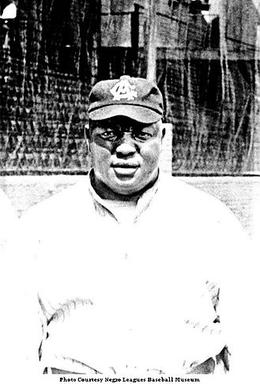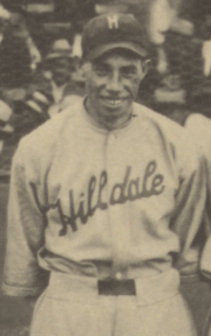Related Research Articles

Andrew "Rube" Foster was an American baseball player, manager, and executive in the Negro leagues. He was elected to the Baseball Hall of Fame in 1981.
The Negro American League was one of the several Negro leagues created during the time organized American baseball was segregated. The league was established in 1937, and disbanded after its 1962 season.

The Mutual Association of Eastern Colored Clubs, more commonly known as the Eastern Colored League (ECL), was one of the several Negro leagues, which operated during the time organized baseball was segregated.
The first Negro National League (NNL) was one of the several Negro leagues that were established during the period in the United States when organized baseball was segregated. The league was formed in 1920 with former player Rube Foster as its president.
The second Negro National League was one of the several Negro leagues that were established during the period in the United States when organized baseball was segregated. The league was founded in 1933 by businessman Gus Greenlee of Pittsburgh.
The Negro World Series was a post-season baseball tournament that was held from 1924 to 1927 and from 1942 to 1948 between the champions of the Negro leagues, matching the mid-western winners against their east-coast counterparts. The series was also known as the Colored World Series, especially during the 1920s, and as the Negro League World Series, in more recent books, though contemporary black newspapers usually called it simply, the "World Series", without any modification. A total of eleven Series were contested in its prime, which ultimately saw nine teams compete for a championship and seven who won at least one. The Homestead Grays were the winningest and most present team in the tournament, winning three times in five appearances, while Dave Malarcher and Candy Jim Taylor won the most titles as manager with two each.

The Kansas City Monarchs were the longest-running franchise in the history of baseball's Negro leagues. Operating in Kansas City, Missouri, and owned by J. L. Wilkinson, they were charter members of the Negro National League from 1920 to 1930. Wilkinson was the first white owner at the time of the establishment of the team. In 1930, the Monarchs became the first professional baseball team to use a portable lighting system which was transported from game to game in trucks to play games at night, five years before any Major League Baseball team did. The Monarchs won ten league championships before integration, and triumphed in the first Negro World Series in 1924. The Monarchs had only one season in which they did not have a winning record and produced more major league players than any other Negro league franchise. It was disbanded in 1965.

William Julius "Judy" Johnson was an American professional third baseman and manager whose career in Negro league baseball spanned 17 seasons, from 1921 to 1937. Slight of build, Johnson never developed as a power threat but achieved his greatest success as a contact hitter and an intuitive defenseman. Johnson is regarded as one of the greatest third basemen of the Negro leagues. In 1975, he was elected into the Baseball Hall of Fame after being nominated by the Negro Leagues Committee.

Wilber Joe Rogan, also known as "Bullet Joe", was an American pitcher, outfielder, and manager for the Kansas City Monarchs in the Negro baseball leagues from 1920 to 1938. Renowned as a two-way player who could both hit and pitch successfully, one statistical compilation shows Rogan winning more games than any other pitcher in Negro leagues history and ranking fourth highest in career batting average. He was elected to the Baseball Hall of Fame in 1998.

James Allen "Candy Jim" Taylor was an American third baseman and manager in Negro league baseball. In a career that spanned forty years, he played as an infielder in the early years of the 20th century for over a dozen black baseball teams; by the mid-1920s, he would play less regularly, with his final game came at 58. In 1920, the same year of the start of the golden era of Negro league baseball, he would take on the responsibilities of manager, where he would manage 1,967 games for twelve teams. Described as one of the great strategists of his era, Taylor is the all-time winningest manager in the Negro league era, having 955 wins along with two Negro World Series titles and one additional pennant in 27 seasons as manager. He has the most seasons managed by an African American manager along with having the seventh most for a manager in the history of baseball.
The Chicago American Giants were a Chicago-based Negro league baseball team. From 1910 until the mid-1930s, the American Giants were the most dominant team in black baseball. Owned and managed from 1911 to 1926 by player-manager Andrew "Rube" Foster, they were charter members of Foster's Negro National League. The American Giants won five pennants in that league, along with another pennant in the 1932 Negro Southern League and a second-half championship in Gus Greenlee's Negro National League in 1934.

James Raleigh "Biz" Mackey was an American catcher and manager in Negro league baseball. He played for the Indianapolis ABCs (1920–1922), New York Lincoln Giants (1920), Hilldale Daisies (1923–1931), Philadelphia Royal Giants (1925), Philadelphia Stars (1933–1935), Washington / Baltimore Elite Giants (1936–1939), and Newark Dodgers/Eagles.

The Hilldale Athletic Club were an American professional Negro league baseball team based in Darby, Pennsylvania, west of Philadelphia.
The Indianapolis ABCs were a Negro league baseball team that played both as an independent club and as a charter member of the first Negro National League (NNL). They claimed the western championship of black baseball in 1915 and 1916, and finished second in the 1922 NNL. Among their best players were Baseball Hall of Fame members Oscar Charleston, Biz Mackey, and Ben Taylor.
The following is a timeline of franchise evolution in Major League Baseball. The histories of franchises in the National Association of Base Ball Players (NABBP), National Association of Professional Base Ball Players (NA), Union Association (UA), and American Association (AA) before they joined the National League (NL) are also included. In 1900 the minor league Western League renamed itself the American League (AL). All of the 1899 Western League teams were a part of the transformation with the Saint Paul Apostles moving to Chicago and to play as the White Stockings. In 1901 the AL declared itself a Major League. For its inaugural major league season the AL dropped its teams in Indianapolis, Buffalo and Minneapolis and replaced them with franchises in Boston, Philadelphia, and Baltimore and the Kansas City Blues moved to Washington to play as the Senators.

George Washington "Dibo" Johnson was an American baseball outfielder in the Negro leagues.

Merven John "Red" Ryan, born Mervin Ferguson, was an American baseball pitcher in the Negro leagues. He played from 1915 to 1932 with several teams, playing mostly with the Hilldale Club.
The 1926 Colored World Series was the championship tournament for the 1926 season of Negro league baseball. It was the third overall Series played. It matched the Chicago American Giants, champions of the Negro National League (1920–1931), and the Bacharach Giants of Atlantic City, New Jersey, champions of the Eastern Colored League. Initially planned as a best-of-nine series, two ties meant that the series went eleven games. Chicago won just once in the first six games, but games 1 and 4 had ended in ties, meaning that they only trailed three games to one when the Series shifted to Chicago. They were down to their final game after losing the eighth game, but the Chicago American Giants proceeded to win the next three games to complete the comeback and win their first ever World Series.
The Memphis Red Sox were an American Negro league baseball team that was active from 1920 to 1959. Originally named the Barber College Baseball Club, the team was initially owned and operated by Arthur P. Martin, a local Memphis barber. In the late 1920s the Martin brothers, all three Memphis doctors and businessmen, purchased the Red Sox. J. B. Martin, W. S. Martin, and B. B. Martin, would retain control of the club till its dissolution in 1959. The Red Sox played as members, at various times, of the Negro Southern League, Negro National League, and Negro American League. The team was never a titan of the Negro leagues like wealthier teams in northern cities of the United States, but sound management lead to a continuous thirty-nine years of operation, a span that was exceeded by very few other teams. Following integration the team had five players that would eventually make the rosters of Major League Baseball teams and two players that were inducted into the Baseball Hall of Fame.
References
- 1 2 3 4 5 6 7 8 9 10 ""Colored Championship" Series (1867-1899)" (PDF). Center for Negro League Baseball Research. Retrieved 8 June 2014.
- 1 2 3 4 5 6 7 8 9 10 11 12 13 14 15 16 17 18 19 20 21 Holway, John (2001). The Complete Book of Baseball's Negro Leagues: The Other Half of Baseball History. Fern Park, Florida: Hastings House Publishers. ISBN 0-8038-2007-0.
- 1 2 3 4 5 6 7 8 9 10 11 12 13 14 15 16 17 18 19 20 ""Colored Championship" Series (1900-1919)" (PDF). Center for Negro League Baseball Research. Retrieved 8 June 2014.
- 1 2 "1910 Season". Negro leagues database (Seamheads.com). Retrieved 10 April 2014.
- 1 2 "1911 Season". Negro leagues database (Seamheads.com). Retrieved 10 April 2014.
- 1 2 "1912 Season". Negro leagues database (Seamheads.com). Retrieved 10 April 2014.
- 1 2 "1913 Season". Negro leagues database (Seamheads.com). Retrieved 10 April 2014.
- 1 2 "1914 Season". Negro leagues database (Seamheads.com). Retrieved 10 April 2014.
- 1 2 "1916 Season". Negro leagues database (Seamheads.com). Retrieved 10 April 2014.
- 1 2 "1917 Season". Negro leagues database (Seamheads.com). Retrieved 10 April 2014.
- 1 2 "1918 Season". Negro leagues database (Seamheads.com). Retrieved 10 April 2014.
- ↑ "1919 Season". Negro leagues database (Seamheads.com). Retrieved 10 April 2014.
- 1 2 3 4 5 6 ""Colored Championship" Series (1920-1931)" (PDF). Center for Negro League Baseball Research. Retrieved 8 June 2014.
- 1 2 3 4 5 ""Play-Off Championship" Series (1925-1929)" (PDF). Center for Negro League Baseball Research. Retrieved 15 March 2014.
- 1 2 3 4 5 6 7 8 9 ""Play-Off Championship" Series (1930-1939)" (PDF). Center for Negro League Baseball Research. Retrieved 15 March 2014.
- 1 2 3 4 5 6 7 8 9 10 ""Play-Off Championship" Series (1940-1955)" (PDF). Center for Negro League Baseball Research. Retrieved 15 March 2014.